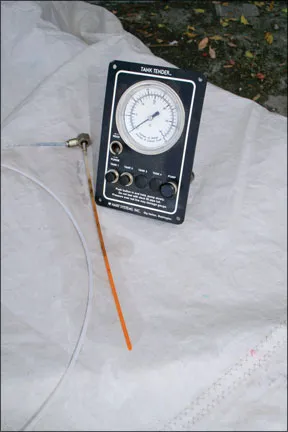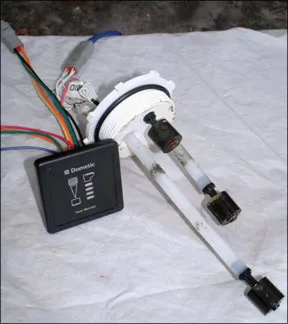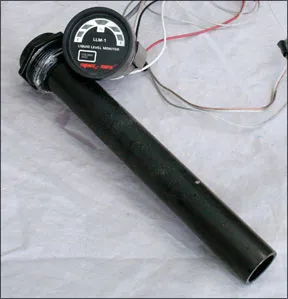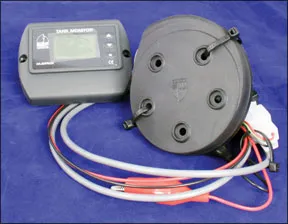In the spring of 2008, Practical Sailor installed and tested seven internally mounted liquid-level sensors and their mated remote monitor panels. Testers evaluated them for ease of installation, quality of workmanship and materials, features, performance, and accuracy. The results were reported in the May 2008 issue. (Externally mounted tank sensors were evaluated in the February 2008 issue.)
In an attempt to replicate real holding-tank conditions for that test, we half-filled a 16-gallon polyethylene tank with water, then added salt, bananas, rolls of toilet paper, and a couple boxes of instant mashed potatoes. It was a goopy mess.

Testers let the tank, with sensors attached, marinate for nine months in the humid, warm Florida weather. When we checked in on the setup, our “fake” holding-tank effluent had grown into a thick, dark, smelly, liquid with an oily, foamy layer on top-just what we were looking for to long-term test the internal probes. But unlike tanks installed on boats kept in the water and used often, our test tank received only occasional “sloshing” over the nine months. However, we were sure to shake things up a bit before re-testing the sensors for this update.
Testers applied power to all kits and observed the readings on the monitors. We then sloshed the lumpy liquid around to simulate the motion of a boat, read the monitors again, and filled the tank with more water to see whether the sensors would indicate the change in liquid level.
What We Tested
The seven kits being tested can be categorized by the type of sensor they use. Those that used some form of float sensor were the SeaLand TankWatch 1, Dometic DTM4, Groco TLM Series, and Wema SHS-8. Two used air pressure for reading: Fireboy-Xintex PTS and Hart Systems Tank Tender. And the BEP Marines TS1 sender uses ultrasonic technology. All should work on standard composite, polyethylene, or aluminum tanks.
Most of the products are rated for wastewater holding tanks, fresh, or “sweet” water tanks, and aluminum or metal fuel tanks for diesel. Gasoline tanks require different sensors.
Some of the single-tank sensors reviewed here also come in multi-tank configurations. All require access to the top of the tank to mount the sensor.
Long-term test results
Hart Tank Tender
The non-electric Hart Systems Tank Tender uses a pneumatic tube and a needle gauge. We switched the pump to “purge” to remove any debris from the tube, switched back to tank No. 1 and got an accurate reading. It also gave an accurate reading when filled. It was not affected by the goop.

Dometic DTM4
The DTM4 comes with three float switches on three adjustable (by cutting) plastic tubes, representing empty, low, mid-level, and full. These are wired to a monitor with corresponding LEDs. This mid-priced device has been around for some time.
Our test unit failed to register at the mid-full level after we added liquid. Upon inspection after the test, testers noted that the gunk had left a greasy sludge on the sensors vertical float slide that may have prevented it from rising. This may not be an issue with freshwater tanks, but could pose a problem if you leave effluent sitting in your holding tank for any length of time. According to Dometic, this is not a common problem and the regular motion of a boat, even when moored, should prevent this from occurring.
Groco Series TLM
Contrary to our expectations, the Groco did not fare very well. The internal mechanism on this unit is two free-floating mercury switches that are attached to a probe with 2-inch wires. The monitor has two LED lights marked ” and “,” which should illuminate when the “Show Level” switch is pushed.
During the check up, only the LED lit up after sloshing the tank, tapping the monitor, and adding water. PS testers speculated that some of the floating debris might have prevented the mercury float switch from closing the contact. However, we discovered the actual problem when we pulled the sensors out of the tank: Some chemical reaction had eaten away the rubber covering on both float switches and was working on the probe tube.
According to Groco, this failure was due to a problem with the coating mixture, and the damage would be covered by the units warranty.

Sealand TankWatch 1
Sealand TankWatch takes the inexpensive approach with one float switch at the top of the tank and a simple red LED marked “Tank Full” on the monitor. Since the short probe was not affected by our goop, it worked fine when the tank was absolutely full, but this type of monitor is of limited value to a cruising sailor.
Wema SHS-8
The Wema kit comprises a float switch mounted on an 8-inch vertical stainless-steel tube, encased in a 1-inch protective stainless-steel pipe.
In the May 2008 review, this kit got Practical Sailors nod as the Budget Buy because of its reasonable price, heavy-duty construction with protection for the float and the continuous-read, responsive needle-gauge indicator panel. Again, it gave the correct readings during our checkup test, and the float was not fouled with the goop.

Fireboy-Xintex PTS/ LLM
The PTS/ LLM uses pneumatic technology (air pressure) and has no moving parts that can become fouled. It was our Best Choice kit in the May 2008 review because of the new pneumatic probe with encapsulated microprocessor sender and the simple electronic level gauge.
A receiver screwed on the top of the tank is attached to a cut-to-length 1-inch plastic tube inserted in the tank. In our test, this tube was not fouled in any way, and the five-LED monitor (marked “E,” “,” “,” “,” and “F”) responded correctly to the various tank levels.
Care should be taken in figuring how high the sender unit sits on the top of the tank and exactly how deep the air tube should be cut. Tube sender sizes are available from 7 inches to 36 inches in 1-inch intervals. Note that the tube can be cut shorter if necessary and the sender re-calibrated.
BEP Marines TS1
BEPs TS1, tested with the 600-TLM monitor display, had the most unique and sophisticated system of any tank monitor we tested. It uses an acoustic sonar technology to read the amount of liquid in a tank. The ultrasonic technology is extremely accurate, and the digital screen shows liquid levels three ways: in gallons, as a percentage full, and with a bar graph.
In the May evaluation, PS testers were concerned that the sensor was too delicate, too complicated, and being new (released in late 2007), too untested. However, after nine months in the goop and the brutal Florida heat, it fired up and worked flawlessly. There is no way for the “gunk” to foul it up.
Although BEP products are made in New Zealand, the company is part of Marinco Electrical Group, a U.S.-based company with sales and service offices worldwide.After a year in production, the companys only reported concerns were a compatibility issue and the possibility that the TS1s nitrite gasket could be over-tightened and give a false reading. The TS1 may not be compatible with some electronic analogue systems, like Vessel View, which is popular on powerboats. BEP is working on an updated model that will be compatible with all systems. Also, new units have a rubberized cork gasket that has solved the gasket problem, BEP said.

Conclusions
Practical Sailor
After nine months of testing, the Fireboy-Xintex pneumatic kit, with the single tank indicator and costing just over $140, is highly recommended. It is simple, has no moving parts, and includes a compact, easy-to-read liquid level display. The Hart Tank Tender is a quality, tried and true product. Its easy to install with a simple thin nylon pneumatic tube that can be run up to 1,000 feet and a precise monitor panel that will display multiple tanks and does not require any power. At more than $400, its a little pricey, but we recommend it for those cruising away from home for long periods.
The Wema was the only kit ringing in under $100. Its accurate and fairly easy to install, so it gets the Budget Buy nod.
The BEP TS1/600-TLM system really intrigued our PS testers. At $380, it is not cheap, but the sonar technology worked flawlessly, was easy to install, and has a host of interesting features and functions. It must be factory programmed for your tanks, but the sender can be used for fuel and can be set up to work with other indicator monitors. The 600 TLM will monitor up to three tanks with selectable labels in English, adjustable high-low level alarms, and is backlit for easy nighttime viewing. It seems reliable and really fits those who love new electronic gadgets. Its the Best Choice.

On the Horizon
Since our test began in 2008, some new tank monitoring systems have hit the market. Among them is marine toilet maker Raritan Engineerings (www.raritaneng.com) recently released Smart Tank Monitor, which is to be used with the HT-100 and HT-100P sensors. This system uses air pressure to measure the liquid level, similar to the Fireboy-Xintex we tested, and has a digital display. The internal sensor is designed to work on all types of tanks and in all types of liquids. We plan to test the Smart Tank along with new external tank sensors. Look for the report in an upcoming issue. does not recommend float-switch level indicators in holding tanks because of the propensity for fouling, especially if the tanks are left standing with solid wastes.



































When all of my tank indicators, including the fuel tank gauge, failed, I replaced then with Airmar ultrasonic level indicators. These mounted in the same tank holes as the previous float gages. The new gages have been in use for about two years and have been reliable so far. Readings have been at least as accurate as the float gages when they were working. The holding tank level gages operate about as well as the fuel and water.
The system was cost effective compared to the alternatives, partly because the read out panel cost was shared over multiple tanks. I put the tank gages on a dedicated NEMA 2000 network.